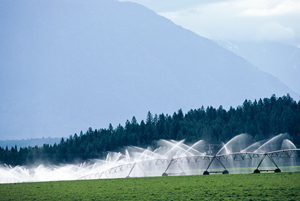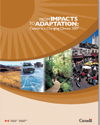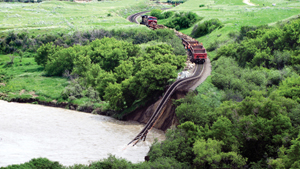CHAPTER 1: An Introduction to Climate Change Adaptation
The Earth’s climate is changing. Some of this change is due to natural variations that have been taking place for millions of years, but increasingly, human activities that release heat-trapping gases into the atmosphere are warming the planet by contributing to the “greenhouse effect.”
The Intergovernmental Panel on Climate Change concludes that the best estimate for global average surface air warming over the current century ranges from 1.8°C to 4.0°C (IPCC 2007). This rate of temperature change is without precedent in at least the last 10 000 years. Consequently, historical climate no longer provides an accurate gauge for future climate conditions.
What is climate change adaptation?
Even after introducing significant measures to reduce greenhouse gas (GHG) emissions, some additional degree of climate change is unavoidable and will have significant economic, social and environmental impacts on Canadian communities. To reduce the negative impacts of this change and to take advantage of new opportunities presented, Canadians will need to adapt.

Photo courtesy of Agriculture and Agri-Food Canada
Climate change adaptation refers to actions that reduce the negative impact of climate change, while taking advantage of potential new opportunities. It involves adjusting policies and actions because of observed or expected changes in climate. Adaptation can be reactive, occurring in response to climate impacts, or anticipatory, occurring before impacts of climate change are observed. In most circumstances, anticipatory adaptations will result in lower long-term costs and be more effective than reactive adaptations.
Adaptation is not a new concept: Canadians have developed many approaches to effectively deal with the extremely variable climate. For example, communities in the Prairie provinces have been designed to withstand extreme differences in seasonal temperatures. Nevertheless, the amount and rate of future climate change will pose some new challenges. The fact that science now allows communities to anticipate a range of potential climate conditions, and therefore take action before the worst impacts are incurred, makes adaptation to future climate change different from how Canadians have adapted historically.

Photo courtesy of Jerry Mouland
Adaptation (responding to climate impacts) and mitigation (reducing GHG emissions) are necessary complements in addressing climate change. The fourth assessment report of the Intergovernmental Panel on Climate Change states that while neither adaptation nor mitigation actions alone can prevent significant climate change impacts, taken together they can significantly reduce risks. Mitigation is necessary to reduce the rate and magnitude of climate change, while adaptation is essential to reduce the damages from climate change that cannot be avoided.
Single policies and measures can be designed to help tackle both mitigation and adaptation. For example, as the climate changes, a projected higher frequency and intensity of rain storms may increase stormwater runoff and the potential for localised flooding in urban areas. Planting street trees is an initiative that municipalities can implement to both reduce stormwater runoff (adaptation) and increase carbon storage (mitigation).
In other cases, there may be conflicts between adaptation and mitigation goals that can only be addressed in a broader context of community priorities and risk tolerance. For example, increased use of air conditioning can be considered an adaptive measure because it reduces human health problems during heat waves, which are projected to become more frequent in future. However, air conditioning is energy intensive and, depending on the source of the electricity, is likely to increase carbon dioxide emissions. Therefore, in deciding which adaptation action is most appropriate for a particular situation, attention must be paid to its implications for adaptation and mitigation, as well as its cost, efficacy and acceptance by the public.
Why Canadian municipalities need to adapt
Learn more about climate change impacts and adaptation in Canada

From Impacts to Adaptation: Canada in a Changing Climate 2007 presents the current understanding of the ongoing and future impacts of climate change on Canada and the country’s ability to adapt. Regional chapters in the book identify key issues and provide examples of adaptation initiatives in British Columbia, the Prairies, Ontario, Quebec, Atlantic Canada and the North. The “Synthesis” chapter presents 10 key conclusions at the national level.
Gradual shifts in average conditions (temperature, precipitation and sea level) will be accompanied by changes in climate variability and the frequency of extreme weather and climate events. The impacts of changing climate are already evident in every region of the country, especially in Canada’s North where impacts are associated with warming that is taking place at faster rates than those throughout the country as a whole.
Anticipated impacts across Canada include increased frequency and severity of extreme weather events (e.g. heat waves, floods, coastal storm surges and droughts), more smog episodes and disease outbreaks, thawing of permafrost, loss of northern sea ice, and rising sea levels. These impacts will affect municipalities large and small, urban and rural, and have both positive and negative implications on infrastructure (e.g. transportation, water supply, sewage), social and economic systems (e.g. human health, competitiveness, recreation) and natural environ-ments (e.g. biodiversity loss, habitat degradation, invasive species).
Climate change impacts in Canada
Projected rapid changes in the climate system will increasingly pose significant challenges in Canada. Some primary biophysical impacts of concern include:
- permafrost thawing, with the associated effects on northern infrastructure
- warming and prolonged drought, making forests more susceptible to fires and insect infestations
- increased drying of the continental interior, reduced snow packs and shrinking glaciers, leading to water shortages for agriculture, hydroelectric facilities, shipping, municipal water supplies and other uses
- increasing frequency of heat waves and smog episodes, causing morbidity and mortality, notably in large cities where heat island effects amplify these events
- increasing severity and frequency of some extreme weather events and associated natural hazards such as floods, impacting economic activities, infrastructure and health
- increasing coastal exposures to storm surges due to increases in the number and intensity of storms, combined with higher sea levels, leading to erosion and infrastructure damage
- damage to habitat for vulnerable species, impacting the local economy and traditional ways of life in some communities

Photo courtesy of Debbie Hollick
Impacts of recent extreme weather events highlight the vulnerability of Canadian communities and critical infrastructure to climate change. The costs resulting from extreme weather events in Canada over the past 15 years have been greater than for all previous years combined. Hundreds of millions and even billions of dollars in property damage and disruptions in the production and flow of goods and services have been associated with flooding, wind, hail and ice storms, hurricanes, tornados and wild fires in all regions of southern Canada. Increases in the frequency and intensity of extreme weather, as is projected to occur with continued climate change, will also affect the cost and availability of insurance and impact governments where they serve as insurers of last resort.
Local governments have a unique and critical role to play in managing the risks of a changing climate. While all levels of government have important adaptation responsibilities, the local nature of many climate impacts means that municipalities are often on the front line to ensure effective management of risks, protect community safety and promote economic sustainability. Municipalities are well positioned to implement adaptive measures, particularly through processes such as land use planning, community energy planning and mechanisms like zoning or permit regulations. For many communities, changes in climate variability, as reflected in less predictable weather events, may represent a greater challenge for planning than will changes in average climatic conditions.
The actions taken today by towns and cities to enhance community resilience to climate change will greatly influence their ability to meet future sustainability goals, as well as to pay for the human and economic costs of climate-related impacts. The case studies in this report provide several examples of relatively low-cost actions, particularly through planning processes, being taken by communities today that are designed to reduce costs of future impacts.
| Weather event | Region | ($) Cost |
|---|---|---|
| 1998 Ice storm | Ontario, Quebec, Atlantic Canada |
~5.4 billion |
| 1996 Saguenay flood | Quebec | 1.7 billion |
| 1991 Calgary hailstorm | Alberta | 884 million |
| 1997 Red River flood | Prairies | 817 million |
| 2003 British Columbia / Alberta wildfires | British Columbia, Alberta | ~700 million |
| 2005 Toronto extreme rain | Ontario | >500 million |
| 2005 Southern Alberta floods | Alberta | 400 million |
| 1996 Calgary hailstorm | Alberta | 305 million |
| 2003 Hurricane Juan | Atlantic Canada | 200 million |

Photo courtesy of Ole Mikkelsen
Page details
- Date modified: